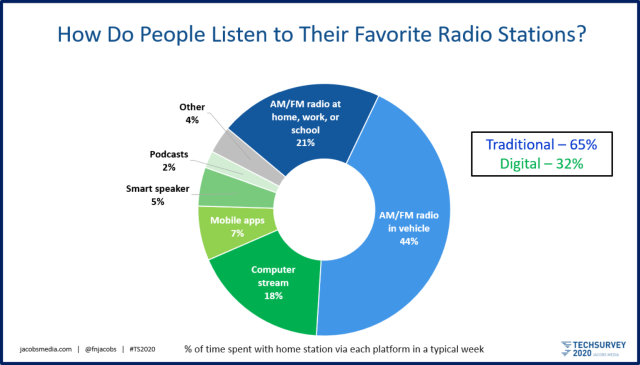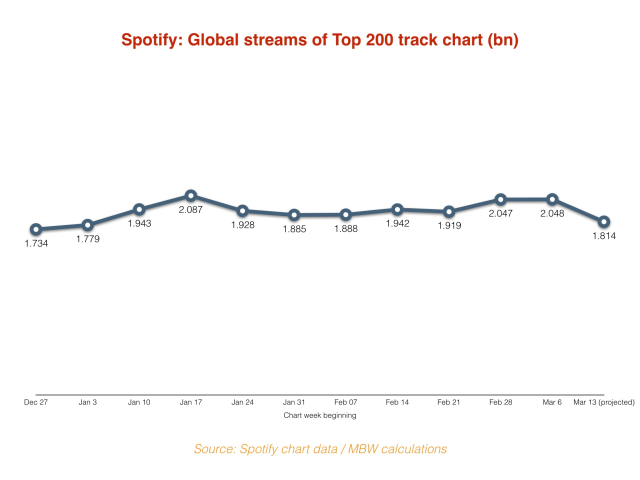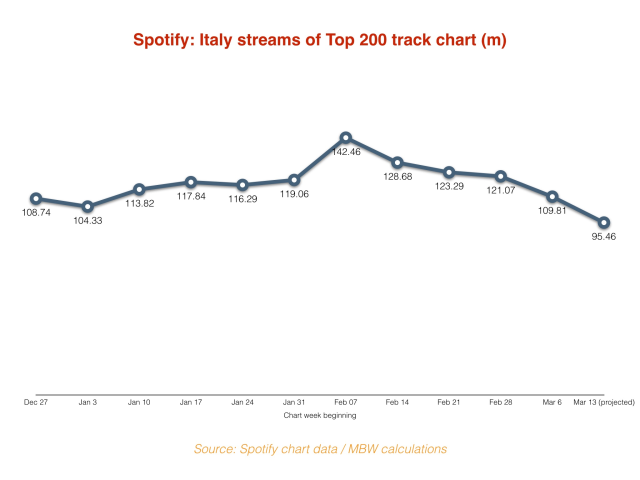A couple of audio consumption numbers got our attention this morning. They indicate that consumer listening might be shifting in unexpected ways as lifestyle habits are disrupted.
The first number: AM/FM radio
From Fred Jacobs, promoting the upcoming release of Techsurvey 2020 (“What Is The Biggest Finding In Techsurvey 2020?“), pinpoints data which in normal times wouldn’t raise an eyebrow. In this survey of avid radio listeners, 65% of respondents say they listen in the car (and we can presume a lot of that is commuting to work) and/or at “home, work, or school.” Nearly all of that (excepting “home”) represents a lifestyle that has been yanked away by coronavirus. More on the significance of that below.

The second number: Spotify streaming
From Music Business Worldwide (MBW), an anlsysis of Spotify streaming volume, based on the Global 200 public playlist. That product normally serves about two-billion streams a week. MBW’s analysis for the week ending March 13 projects 1.814-billion streams, the lowest total for a full week in 2020. (It’s a projection based on partial data, about which MBW says it is “confident.”)

MBW doubles down on the revealing research with a similar chart of Italian listening, remembering that Italy is a few weeks deeper into the coronavirus crisis than U.S. and many other countries:
 What it means (maybe)
What it means (maybe)
In a few words: Staying home doesn’t necessarily mean more listening.
Daily routines in the U.S. (and in Europe and Asia) have been abruptly altered as states close down businesses and regulate how people move through their day-to-day lives. “Shelter in place” rules in New York, California, and a growing list of other states are keeping people in their homes. That shift pulls people out of their workplaces, out of their cars or public transportation during traditional commuting hours, out of gyms where headphones are nearly as important as the exercise machines.
Here is our point: The key word is “routines.” A routine is not only where you are, but what you habitually do in that time and place. Commuting in the car involves a bundle of habits that could include driving, listening, getting coffee, calling your mom. Those habits are not necessarily attached to time of day, as much as commuting during that time. The routine is not “morning from 8:00 to 8:30” — the routine is “commuting in the car.”
In that light, Fred Jacobs makes a good point in calling out what would ordinarily be a humdrum statistic.
The thesis here goes against intuition. Enforced at-home means more listening, right? Maybe it will evolve in that direction. But when listening is powered by complex routines and habit clusters, the equation gets complicated.
This principle of routines, attached to activities more than dayparts, applies to all kinds of mobile listening. An hour at the gym three times a week, listening to streaming audio through wireless earbuds? It cannot be assumed that earbud listening will stay attached to those three hours when the hours become unattached from the gym.
James Cridland discusses this listening falloff in today’s Podnews. In his article “How the coronavirus is affecting podcast downloads” he applies this thinking to podcasts, noting that some podcasters are observing lowered metrics. James’ conclusion: “We think that most podcasters can expect a small decrease, with 20% the rough guideline for now. It remains to be seen how tighter restrictions affect this further, though.”
